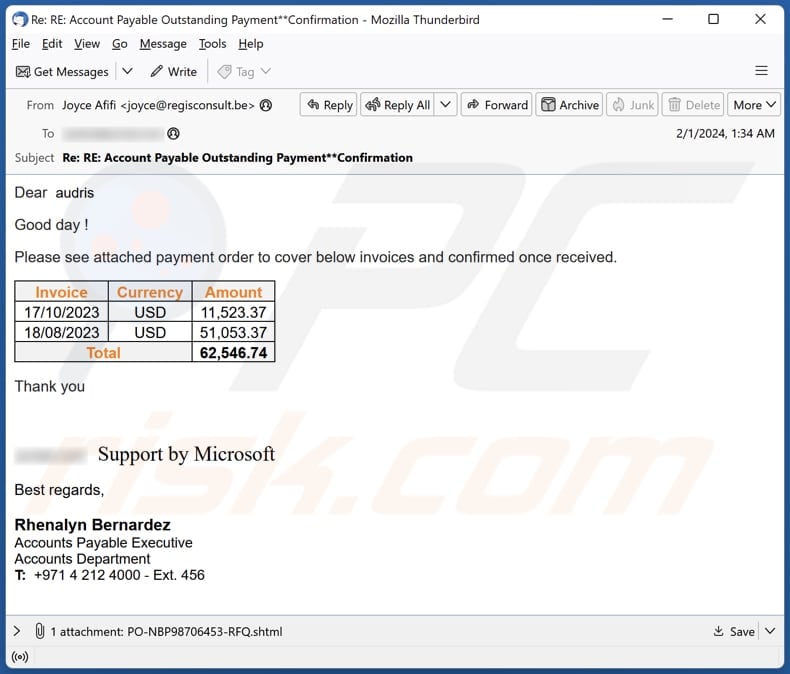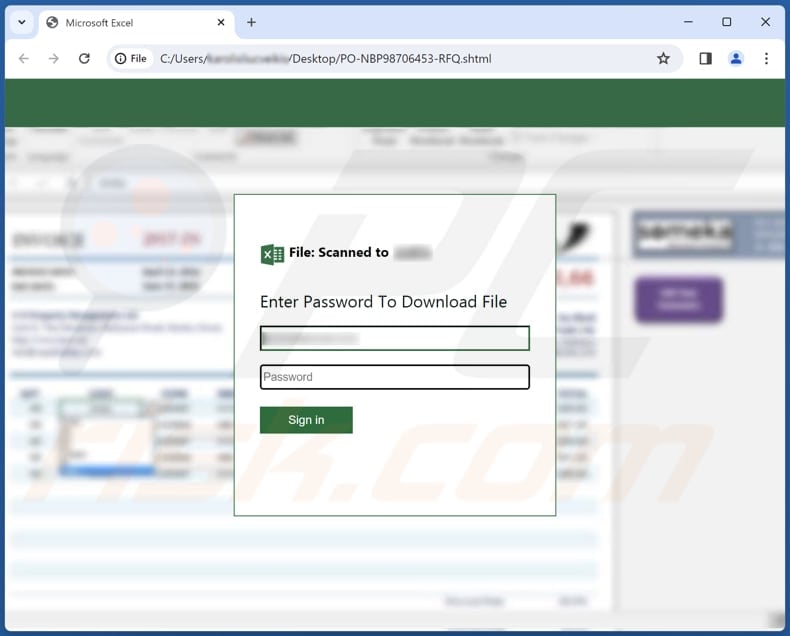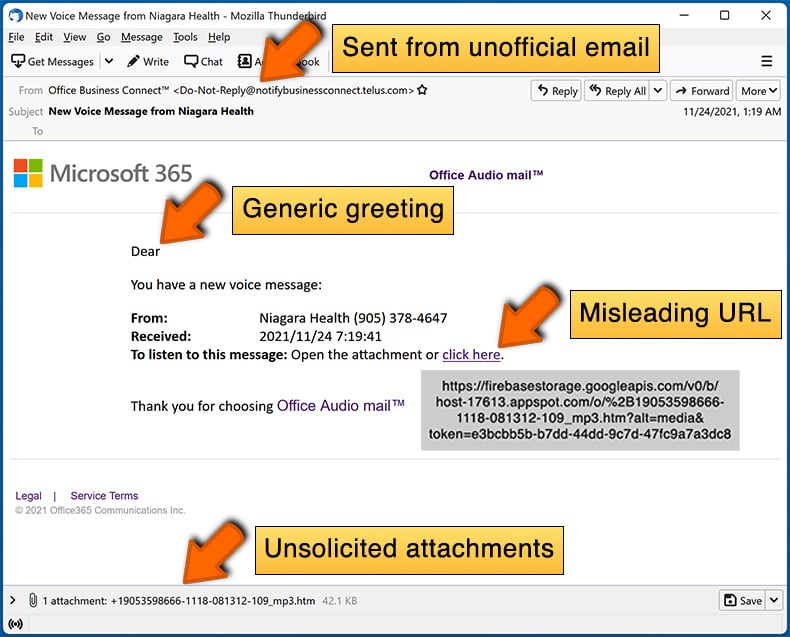Get free scan and check if your device is infected.
Remove it nowTo use full-featured product, you have to purchase a license for Combo Cleaner. Seven days free trial available. Combo Cleaner is owned and operated by RCS LT, the parent company of PCRisk.com.
What kind of scam is "Payment Order"?
Upon closer examination of the email, it has become evident that it is a phishing attempt designed to obtain personal information. The perpetrators behind this phishing scheme aim to trick recipients into opening the attached file and divulging their login credentials. Therefore, emails of this nature and similar ones should be disregarded.

More about the "Payment Order" scam email
This phishing email adopts a deceptive guise of a legitimate business communication regarding outstanding payments. The subject line implies an ongoing conversation, adding a sense of urgency and legitimacy. The body of the email is structured professionally, with the sender posing as a purported accounts payable executive, Rhenalyn Bernardez, seemingly from a reputable company.
The email requests the recipient's attention to an attached payment order purportedly covering specific invoices and amounts. The inclusion of detailed invoice information, such as invoice numbers, currency, and amounts, aims to lend credibility to the request. Additionally, the email ends with a polite closing and contact information, further enhancing the appearance of authenticity.
The attached file to this email is labeled "PO-NBP98706453-RFQ.shtml" (though its name may vary). Upon opening, it presents a counterfeit form, soliciting the input of an email address and password under the guise of downloading a file. It is clear that scammers behind this phishing email aim to steal login credentials.
With the obtained email address and password, scammers may gain unauthorized access to the victim's email account, enabling them to read confidential messages, impersonate the victim, or conduct further phishing attacks targeting contacts within the victim's network.
Also, scammers may exploit the password to attempt unauthorized access to other accounts associated with the victim, such as social media, online banking, or e-commerce platforms. This access could lead to identity theft, financial fraud, or the compromise of sensitive personal information. Furthermore, scammers may sell the obtained information on the dark web.
| Name | Payment Order Email Scam |
| Threat Type | Phishing, Scam, Social Engineering, Fraud |
| Fake Claim | Email has a payment order attached to it |
| Disguise | Legitimate business communication regarding outstanding payments |
| Attachment | PO-NBP98706453-RFQ.shtml (its name may vary) |
| Detection Names (Attachment) | Avast (HTML:PhishingMS-AQP [Phish]), Combo Cleaner (Generic.Fake.Login.G.8653FCD6), ESET-NOD32 (HTML/Phishing.Agent.ELA), Ikarus (Phishing.HTML.Doc), Microsoft (Trojan:Script/Phonzy.B!ml), Full List Of Detections (VirusTotal) |
| Symptoms | Unauthorized online purchases, changed online account passwords, identity theft, illegal access of the computer |
| Distribution methods | Deceptive emails, rogue online pop-up ads, search engine poisoning techniques, misspelled domains |
| Damage | Loss of sensitive private information, monetary loss, identity theft |
| Malware Removal (Windows) |
To eliminate possible malware infections, scan your computer with legitimate antivirus software. Our security researchers recommend using Combo Cleaner. Download Combo CleanerTo use full-featured product, you have to purchase a license for Combo Cleaner. 7 days free trial available. Combo Cleaner is owned and operated by RCS LT, the parent company of PCRisk.com. |
Similar scam emails in general
Emails of this kind typically share common characteristics such as urgent subject lines, requests for immediate action, inclusion of attachments or links, impersonation of trusted entities or individuals, and attempts to elicit sensitive information like login credentials or personal details.
It is important to mention that links and files in emails sent by cybercriminals can be intended to deploy malware. Some examples of scam campaigns targeting sensitive information are "WeTransfer - Order Specifications", "Employees Performance Report", and "Scam Relief Fund Initiative Email Scam".
How do spam campaigns infect computers?
Computer infections often stem from users inadvertently interacting with malicious elements in phishing emails. These emails may prompt users to open attachments or click on links, unwittingly triggering the download and execution of malware onto their systems.
Malware-infected attachments commonly include executable files like .exe or .bat, Microsoft Office documents such as .doc or .xls, PDF files, compressed archives like .zip or .rar, and JavaScript files like .js. Once activated, these attachments can compromise the security of the user's computer.
How to avoid installation of malware?
Be cautious when dealing with unexpected emails from unknown sources. Do not open attachments or click links unless their legitimacy is verified. Keep all software up to date, including your operating system and antivirus software. Avoid interacting with advertisements and pop-ups on questionable websites.
Obtain programs and files solely from trusted sources like official websites and app stores. Steer clear of downloading illegal software or cracking tools. Perform routine scans of your computer to detect any potential risks. If you have already opened malicious attachments, we recommend running a scan with Combo Cleaner Antivirus for Windows to automatically eliminate infiltrated malware.
Text presented in the "Payment Order" email letter:
Subject: Re: RE: Account Payable Outstanding Payment**Confirmation
Good day !
Please see attached payment order to cover below invoices and confirmed once received.
Invoice Currency Amount
17/10/2023 USD 11,523.37
18/08/2023 USD 51,053.37
Total 62,546.74
Thank you
- Support by MicrosoftBest regards,
Rhenalyn Bernardez
Accounts Payable Executive
Accounts Department
T: +971 4 212 4000 - Ext. 456
Fake sign-in form within the attached file ("PO-NBP98706453-RFQ.shtml"):

Instant automatic malware removal:
Manual threat removal might be a lengthy and complicated process that requires advanced IT skills. Combo Cleaner is a professional automatic malware removal tool that is recommended to get rid of malware. Download it by clicking the button below:
DOWNLOAD Combo CleanerBy downloading any software listed on this website you agree to our Privacy Policy and Terms of Use. To use full-featured product, you have to purchase a license for Combo Cleaner. 7 days free trial available. Combo Cleaner is owned and operated by RCS LT, the parent company of PCRisk.com.
Quick menu:
- What is Payment Order phishing campaign?
- Types of malicious emails.
- How to spot a malicious email?
- What to do if you fell for an email scam?
Types of malicious emails:
![]() Phishing Emails
Phishing Emails
Most commonly, cybercriminals use deceptive emails to trick Internet users into giving away their sensitive private information, for example, login information for various online services, email accounts, or online banking information.
Such attacks are called phishing. In a phishing attack, cybercriminals usually send an email message with some popular service logo (for example, Microsoft, DHL, Amazon, Netflix), create urgency (wrong shipping address, expired password, etc.), and place a link which they hope their potential victims will click on.
After clicking the link presented in such email message, victims are redirected to a fake website that looks identical or extremely similar to the original one. Victims are then asked to enter their password, credit card details, or some other information that gets stolen by cybercriminals.
![]() Emails with Malicious Attachments
Emails with Malicious Attachments
Another popular attack vector is email spam with malicious attachments that infect users' computers with malware. Malicious attachments usually carry trojans that are capable of stealing passwords, banking information, and other sensitive information.
In such attacks, cybercriminals' main goal is to trick their potential victims into opening an infected email attachment. To achieve this goal, email messages usually talk about recently received invoices, faxes, or voice messages.
If a potential victim falls for the lure and opens the attachment, their computers get infected, and cybercriminals can collect a lot of sensitive information.
While it's a more complicated method to steal personal information (spam filters and antivirus programs usually detect such attempts), if successful, cybercriminals can get a much wider array of data and can collect information for a long period of time.
![]() Sextortion Emails
Sextortion Emails
This is a type of phishing. In this case, users receive an email claiming that a cybercriminal could access the webcam of the potential victim and has a video recording of one's masturbation.
To get rid of the video, victims are asked to pay a ransom (usually using Bitcoin or another cryptocurrency). Nevertheless, all of these claims are false - users who receive such emails should ignore and delete them.
How to spot a malicious email?
While cyber criminals try to make their lure emails look trustworthy, here are some things that you should look for when trying to spot a phishing email:
- Check the sender's ("from") email address: Hover your mouse over the "from" address and check if it's legitimate. For example, if you received an email from Microsoft, be sure to check if the email address is @microsoft.com and not something suspicious like @m1crosoft.com, @microsfot.com, @account-security-noreply.com, etc.
- Check for generic greetings: If the greeting in the email is "Dear user", "Dear @youremail.com", "Dear valued customer", this should raise suspiciousness. Most commonly, companies call you by your name. Lack of this information could signal a phishing attempt.
- Check the links in the email: Hover your mouse over the link presented in the email, if the link that appears seems suspicious, don't click it. For example, if you received an email from Microsoft and the link in the email shows that it will go to firebasestorage.googleapis.com/v0... you shouldn't trust it. It's best not to click any links in the emails but to visit the company website that sent you the email in the first place.
- Don't blindly trust email attachments: Most commonly, legitimate companies will ask you to log in to their website and to view any documents there; if you received an email with an attachment, it's a good idea to scan it with an antivirus application. Infected email attachments are a common attack vector used by cybercriminals.
To minimise the risk of opening phishing and malicious emails we recommend using Combo Cleaner Antivirus for Windows.
Example of a spam email:

What to do if you fell for an email scam?
- If you clicked on a link in a phishing email and entered your password - be sure to change your password as soon as possible. Usually, cybercriminals collect stolen credentials and then sell them to other groups that use them for malicious purposes. If you change your password in a timely manner, there's a chance that criminals won't have enough time to do any damage.
- If you entered your credit card information - contact your bank as soon as possible and explain the situation. There's a good chance that you will need to cancel your compromised credit card and get a new one.
- If you see any signs of identity theft - you should immediately contact the Federal Trade Commission. This institution will collect information about your situation and create a personal recovery plan.
- If you opened a malicious attachment - your computer is probably infected, you should scan it with a reputable antivirus application. For this purpose, we recommend using Combo Cleaner Antivirus for Windows.
- Help other Internet users - report phishing emails to Anti-Phishing Working Group, FBI’s Internet Crime Complaint Center, National Fraud Information Center and U.S. Department of Justice.
Frequently Asked Questions (FAQ)
Why did I receive this email?
Scammers send out identical emails to a large number of recipients with the expectation of deceiving at least one individual. These spam emails typically lack personalization, as scammers seldom focus on any specific individual.
I have provided my personal information when tricked by this email, what should I do?
Promptly update your password for the affected account and closely monitor your account for any unusual activity. Additionally, it is recommended to inform the relevant authorities or the entity overseeing the compromised account about the incident.
I have downloaded and opened a malicious file attached to an, is my computer infected?
The likelihood of your computer being infected depends on the nature of the file you downloaded and opened. For instance, if you download and open an executable file, there is a higher risk of infection. However, opening a Microsoft Office document poses a lower risk of infection since malware cannot enter a system unless macro commands are enabled.
I have read the email but did not open the attachment, is my computer infected?
Merely opening an email presents no danger to your system. System infections cannot occur through email without clicking links or opening attachments.
Will Combo Cleaner remove malware infections that were present in email attachment?
Combo Cleaner can efficiently detect and eliminate almost all known malware infections. However, it is crucial to recognize that sophisticated malware often hides deeply within the system. Therefore, conducting a comprehensive system scan is essential to guarantee detection and removal.
Share:

Tomas Meskauskas
Expert security researcher, professional malware analyst
I am passionate about computer security and technology. I have an experience of over 10 years working in various companies related to computer technical issue solving and Internet security. I have been working as an author and editor for pcrisk.com since 2010. Follow me on Twitter and LinkedIn to stay informed about the latest online security threats.
PCrisk security portal is brought by a company RCS LT.
Joined forces of security researchers help educate computer users about the latest online security threats. More information about the company RCS LT.
Our malware removal guides are free. However, if you want to support us you can send us a donation.
DonatePCrisk security portal is brought by a company RCS LT.
Joined forces of security researchers help educate computer users about the latest online security threats. More information about the company RCS LT.
Our malware removal guides are free. However, if you want to support us you can send us a donation.
Donate
▼ Show Discussion